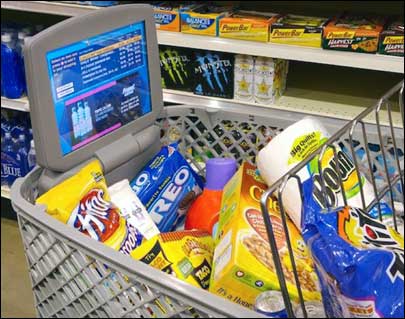Having completed an initial, nine-month test of its RFID-powered shopping carts at two New Jersey ShopRite supermarkets, MediaCart is now gearing up for a second, larger pilot that will incorporate a number of functions designed to help shoppers save time and money.
MediaCart’s product is a standard shopping cart with an integrated, battery-powered video monitor and a ThingMagic EPC Gen 2 RFID interrogator. During the first phase of the pilot, Avery Dennison passive EPC Gen 2 RFID tags were attached to store shelves. As shoppers pushed the carts down the aisles, the interrogators read the tags’ encoded IDs and transmitted them, via the test stores’ Wi-Fi networks, to MediaCart’s software (see Wheeling Into the Future.

The software, built on the Microsoft Windows CE operating system, searched a Microsoft SQL Server database to identify the products displayed on those shelves. Based on that data, the software sent commands back to the carts’ monitors to play select video advertisements, streamed using Microsoft’s Atlas Ad Server, for goods located in proximity to those shoppers. For example, directing a cart down the cookie aisle and past a tag near Nabisco products might have prompted an Oreos advertisement to play on the screen.
According to Microsoft, the second trial—which will take place in the same two ShopRite stores that hosted the first—is expected to begin in the second half of 2008. In addition to the same ad-serving function tested during the first phase, the second will enable customers to personalize their experience.
To do this, a consumer will be able to upload a shopping list at home, using a ShopRite Web page, then upload the list to the video monitor on a cart inside a test store, by using a bar-code reader mounted on the cart to scan the bar code printed on his or her ShopRite Price Plus loyalty club card. The shopping list will appear along with a map of the store’s floor plan, and the products will be displayed in order of aisle number, so that a shopper will be able to find the items consecutively without backtracking.
Once a customer logs on to the system via the shopping cart, the ads served will be based on that member’s buying history. For example, a shopper who regularly purchases oatmeal might be presented with a special offer—an electronic coupon for a new hot cereal. (According to a Microsoft spokesperson, it has not yet been determined just how consumers will redeem such coupons.) Shoppers will also be able to utilize the bar-code reader to scan each product placed in the cart, to view the purchase total on the cart’s screen. In the future, should RFID tags replace the bar codes on individual products, the cart’s embedded RFID interrogator would read the products’ tags to tally up the items.
According to press reports, MediaCart collected a number of responses and reactions to the first phase of the pilot, both from consumers and ShopRite personnel, and is now using that feedback to plan the test’s second phase. MediaCart has not responded to RFID Journal‘s requests for an interview, nor, as of press time, has ShopRite’s parent company, Wakefern.

